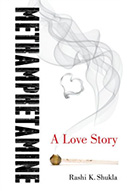Methamphetamine: A Love Story

Author: Rashi Shukla
Publisher: Oakland, CA: University of California Press, 2016. 264p.
Reviewer: Judith Ryder | July 2018
In the opening Author’s Note, Rashi Shukla warns readers that her book, Methamphetamine: A Love Story, is inappropriate for “young children, the faint of heart, and those not interested in knowing.” She does not exaggerate. Turning the page to Chapter One, An Introduction to Darkness, one is immediately yanked into a place where “there is no light”; where a young man seduced by what methamphetamine seems to offer “come[s] face to face with the darkness” and in utter despair shoots himself in the head. He survives to tell his story “so that you would know” (p. 3). The opening chapter proceeds to briefly sketch the history of methamphetamine use in the United States, and identifies six major drug-related public health issues that effect the lives of users and non-users alike: child endangerment, abuse, and neglect; toxic places; intravenous drug use; risky sex; risky drug use; and violence. Each of these is subsequently addressed in the personal stories that follow—narratives Shukla skillfully elicited from 33 methamphetamine users over the course of four years.
This love story, however, is not about wide-ranging drug problems in the United States. It is the story of the unique underground world of methamphetamine as it exists in Oklahoma: a sparsely populated state in the middle of the country, comprised of small, rural communities, “primarily Caucasian and conservative…part of what as known as the Bible Belt” (p. 15). Shukla provides general information about her efforts to conduct a study of this kind, in this place, noting the difficulty of locating potential interviewees in such a hidden and sometimes dangerous population, and the delicacy of “unobtrusively asking callers if they had ever dealt or manufactured, without sounding like an undercover police officer or a complete idiot” (p. 14). The resultant sample consists of female and male adults, all of whom resided in Oklahoma at the time of the interviews. Countering stereotypes, the majority of respondents (78.8 percent) were employed and nearly two-thirds had some college education. Most also had some criminal justice system involvement; nearly 94 percent had been incarcerated. Twenty-three individuals (17 males and 6 females) had been manufacturers, some with histories that extended back as far as 1994.
The initial chapter sets the course, while the next, Pathways to Methamphetamine, examines the context of users’ early lives, which included (for some) child abuse and neglect and adolescent drug experimentation. All interviewees affirmed that early drug use was initiated with family and peers, and with substances other than methamphetamine (meth). None had knowledge of meth and its effects prior to the first time they tried it. Chapter Three, Loving Meth, explores the earliest phase of what for most develops into an all-encompassing drug lifestyle. Users expound upon their increased sense of well-being and high energy, and the sheer fun of using methamphetamine. Tasks are accomplished, weight loss achieved, and sex is intensified: Lucas exclaims, “Everybody’s happy.… Everything works perfect on methamphetamine” (p. 51). This new “dance with chance” (p. 53) is exhilarating, for it promises all things desirable and almost instantaneously transforms one’s busy but “boring” life into one where as Evan asserts, “…I would never feel bad” (p.41).
Readers are swept along in the excitement but are soon confronted with the more dangerous and sordid aspects of the meth lifestyle. The detailed stories of the men and women who have stopped using (at this point in time, anyway) challenge us to look beyond the chemical substance of methamphetamine and its physical effects. We are asked to understand the full context, to try and put ourselves in the shoes of users, dealers, and manufacturers when they explain how they became infatuated with this potent drug, fell in love, and proceeded to do whatever it took to keep the love alive. The ensuing chapters guide us beyond the initial allure and describe the intricacies of Dealing Meth and Manufacturing Meth. While the stories move quickly through the intertwined dimensions of each segment of a common trajectory, the discussion of manufacturing, with all its variations in motives, styles, and methods, is of particular interest. As the author notes, manufacturing “represents the deepest level of immersion in the world of methamphetamine” (p. 73). It is here, at the core, that it becomes very clear that cooking can be as addictive as the drug itself. Nicholas explains how manufacturing provided the power and respect he lacked in high school: “When I cooked all of a sudden I had all these people who were twice my age, just looking at me like I was king….it’s just, it’s a power trip, here I am this teenager and these women are throwing theirself at me, and just, I felt like a rock star” (p. 85). Dillon concurs: “…all of a sudden, everybody needs you, they come to you for their drugs and all that, and it’s just a feeling of power and importance, you’re somebody” (p.105).
In addition to power, prestige, and money, cooks enjoy the creative act: Wes describes, “just watching the process…that effect of aaahhh”(p.76). Ava claims “the cookin’ just does somethin’ to you. It turns you into like a mad scientist…think of your most favorite thing and you can just make it appear” (p. 84). To Patrick, too, the chemical process is fascinating: “…all you’re doing is changin’ one molecule, is all you’re doin’…to watch liquid turn into powder…it’s neat…It’s fun to make” (p. 85).
The next set of chapters proceed to detail what is in turns, An Intoxicating Life, A Risky Life, and finally, A Dark Life. The concluding chapters, Life After Meth and The Journey Ends?, not only speculate on the destinations of the interviewees, but question those who have been entrusted with these dark stories: As the purported adults in the room, where is our social and political will to engage in creative problem solving, now that we “know”? Shukla offers some recommendations grounded in the recognition that “the drug problem” is just as much an issue of public health as it is a criminal justice concern. Individuals may need to shift their thinking and their behaviors, but it is up to the collective to transform social policies in order to provide the direction and implementation supportive of change on a national scale.
Shukla uses a light touch to provide supplemental background material on methamphetamine’s properties, prior research, and legislation. An analysis of the respondents’ traumatic childhood experiences and possible links to drug use would have been of interest to this reader, and additional information about the study design would help contextualize the extensive qualitative material. But the author’s focus is on the world of using, dealing, and manufacturing—a world few can imagine, much less enter. And thus, Shukla relies heavily on the stories told to her by those intimately involved in this world. Their stories seek to explain why they were seduced, and the extreme difficulties of trying to end their attachment to a substance and lifestyle they still love. The narratives are a tribute to Shukla’s ability to gain the trust of her respondents, and they in turn are generous with their knowledge about how and why this powerful drug became entrenched in a segment of rural America. Methamphetamine: A Love Story is a captivating read, valuable to students, researchers, and policymakers who will come to see why simple, reactive solutions to methamphetamine’s hold will never suffice. Shukla gives us fair warning.


